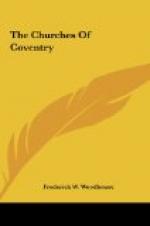On the walls are portraits of later sovereigns from William III to George IV, that of George III being by Lawrence. The Mayoress’ Parlour opening from the dais has been drastically restored. It contains portraits of Queen Mary, Queen Elizabeth, James I, and Charles I, and four benefactors to the city, John Hales, founder of the Free School, Sir Thomas White, Thomas Jesson and Christopher Davenport.
THE CARTHUSIAN MONASTERY
Little remains of this monastery which stood on the south side and not far from the city. The Order settled in Coventry in 1381 only ten years after the foundation of the London Charter-house. At the Dissolution the Prior and brethren, ten in all, did not emulate the heroism of the London monks and were fortunate enough to obtain pensions instead of martyrdom. Some trifling remains exist incorporated in a modern mansion, and a wall of the garden shows the position of doors which led to the isolated cells of the monks. The Botoners had given freely to the building of the church and cloisters of which Richard II laid the first stone in 1385 and afterwards largely endowed “on condition that they should find and maintain within the precinct of their house, twelve poor scholars from seven years old till they accomplished the age of seventeen years, there to pray for the good estate of him the said King and of his Consort, during this life, and for the health of their souls after death.”
FOOTNOTES
[Footnote 1: St. Osburg’s name is not found in the Calendar. As at the Dissolution the Cathedral possessed relics of St. Osborne, including his head in copper and gilt, these saints may be identical.]
[Footnote 2: Earl Street and Bishop Street are still principal streets in either half of the town.]
[Footnote 3: The walls of London were about three and a quarter miles long (including the river front), with ten or eleven gates; those of York three miles, of Chester hardly two.]
[Footnote 4: These have ever since remained prebends of Lichfield.]
[Footnote 5: At the last restoration the height was reduced to 298 feet.]
[Footnote 6: See Fuller’s “Worthies of England.” In 1428 an Act of Leet ordered that no person should dye any wool or cloth with “a deceitful colour called Masters or Medleys brought into Coventry by a Frenchman.”]
[Footnote 7: “English Church Furniture.” (Antiquary series.) J.C. Cox and A. Harvey.]
[Footnote 8: “Coventry: its History and Antiquities,” B. Poole, 1870.]
INDEX
Abbots of Coventry.
Alms-boxes.
Apse.
Bells.
Benefactors of Coventry.
Botoner, William and Adam.
Carthusian Monastery.
Chantries, Foundation of.
Christ Church.
City, History of.
Cross.




